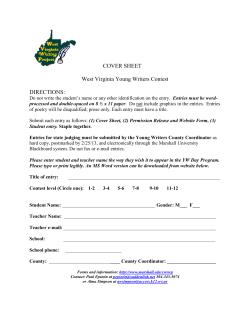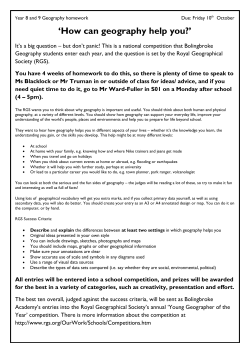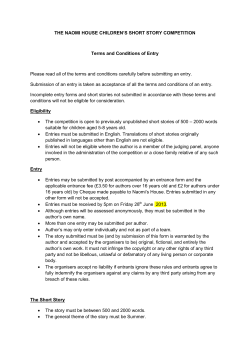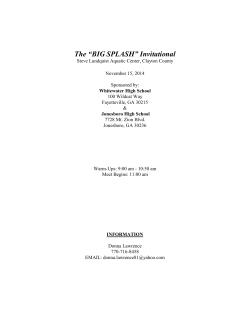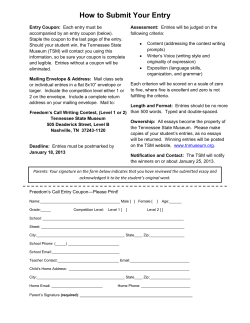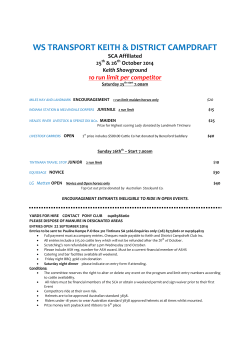
Young Geographer of the Year Competition 2014 “How can geography help you?”
Young Geographer of the Year Competition 2014 Run in conjunction with Geographical Magazine The question for this year’s Young Geographer of the Year is: “How can geography help you?” We want to hear how geography, be it the knowledge you learn, understanding you gain, or skills you develop, helps you across different parts of your life. This help might be at many different levels: At school At home with your family When you travel and go on holidays When you think about current events at home or abroad Whether it will helps you with further study, perhaps at university Or leads to a particular career you’d like to do We are interested in answers which might look at both the serious and the fun sides of geography and particularly want to see how you can relate the value of geography to a number of different settings. We welcome applications which, as appropriate for the age range, recognise the value of both human and physical geography. For the all categories geographical vocabulary needs to be used. We will provide additional credit for entries which use primary data collected by the student, alongside secondary data. Categories: Pupils in the three youngest categories (KS2, KS3 and GCSE) should answer this question using an annotated diagram or map (no larger than A3 in size) Students in the A Level category should answer this question through a 1,500 word essay which can include illustrations, maps or graphs For each category there will be an overall winner and a number of highly commended awards. Where your school has more than ten entries, the Society suggests that your teachers run their own local semi-final and select the best entries (ideally no more than 10) to be entered into the national competition and forward these entries on to the RGS-IBG. Young Geographer of the Year is kindly supported by: Royal Geographical Society (with IBG), 1 Kensington Gore, London, SW7 2AR E ygoty@rgs.org T 020 7591 3045 F 020 7591 3001 www.rgs.org/ygoty2014 Young Geographer of the Year Competition 2014 Run in conjunction with Geographical Magazine “How can geography help you?” For the all categories geographical vocabulary needs to be used. Sources of data should be acknowledged where possible. All entries should be submitted with an entry form, and this must be stapled to any hard copies. Hard copies must be submitted flat or folded, not rolled. Hard copies must not be larger than A3 size. Students must enter the Key Stage category which they will be in as of November 2014. Competition categories There are four categories as follows Key Stage 2 (ages 9-11) Key Stage 3 (ages 11-14) GCSE (ages 14-16) A Level (ages 16-18) Work can be submitted electronically by schools to ygoty@rgs.org. Only MS Word and PDF formatted documents will be acceptable. Hard copies can also be sent through to the address below, FAO Education Department. Judging criteria for Key Stage 2 category Describe one or more settings in which geography helps you in a visual or diagrammatic way We are looking for original ideas presented in your own style—class sets of identical entries will be marked down You can include drawings, sketches, photographs and maps You should include maps, graphs or other geographical information Make sure your annotations are clear Royal Geographical Society (with IBG), 1 Kensington Gore, London, SW7 2AR E ygoty@rgs.org T 020 7591 3045 F 020 7591 3001 www.rgs.org/ygoty2014 Young Geographer of the Year Competition 2014 Run in conjunction with Geographical Magazine Judging criteria for Key Stage 3 category As for Key Stage 2, but you also need to ensure in your entry that you: Describe and explain the differences between at least two settings in which geography helps you Show accurate use of scale and symbols in any diagrams used Use a range of visual data sources Describe the types of data sets compared (i.e. say whether they are social, environmental, political) Judging criteria for GCSE category As for Key Stage 3, but you also need to ensure in your entry that you: Clearly define a number of settings and consider geography in the current news Use of a range of visual data sources, which could include photographs, graphs or inset maps Evaluate the impact, strengths and limitations of the data used Entry Requirements for Key Stage 2, Key Stage 3 and GCSE All entries must be accompanied by an entry form downloadable from www.rgs.org/ygoty2014 Entry form must be stapled to each hard copy entry or included in email with electronic entries Your work must be presented on one side of paper (maximum A3 size– larger will not be accepted) Your work must be visual or diagrammatic Work must be original and all words must be your own. This means work you have done yourself. Individual entries only, no joint entries All entries must go through your school. Where your school has more than ten entries, the Society suggests that your teachers run their own local semi-final and select the best entries (ideally no more than 10) to be entered into the national competition and forward these entries on to the RGS-IBG. For Key Stage 2, Key Stage 3 and GCSE, all work must be submitted by Schools as hard copies or as a PDF/MSWORD and either emailed, posted or hand-delivered to Young Geographer of the Year, Education Team, Royal Geographical Society (with IBG), 1 Kensington Gore, London SW7 2AR or emailed to ygoty@rgs.org The Society regrets that it cannot return any entries or provide feedback on individual entries. Royal Geographical Society (with IBG), 1 Kensington Gore, London, SW7 2AR E ygoty@rgs.org T 020 7591 3045 F 020 7591 3001 www.rgs.org/ygoty2014 Young Geographer of the Year Competition 2014 Run in conjunction with Geographical Magazine Competition details for A Level category Your task is to demonstrate your understanding of this topic with detailed comparisons of a number of geographical settings. We particularly welcome consideration of how geographical help can reach beyond school or sixth form. You may consider both human and physical settings in an essay of 1500 words maximum; it is recommended that you include diagrams and visuals in your essay. We are looking for evidence that you are able to select, describe and analyse appropriate data sets. Judging Criteria for A Level category Introduction which defines the geographical settings chosen and any data sets to be compared Justification of why data sets used in the essay were selected. Appreciation of advantages/disadvantages of primary/secondary data sets used respectively Evidence of first-hand observation of chosen geographical settings. Critical analysis of qualitative/quantitative information collected Critical analysis of each comparison, recognising strengths and weaknesses of the ways in which data is being presented Effective presentation of a range of data, including graphs and tables, with effective linking to the text of the essay Strong conclusion Confident use of specialist vocabulary Entry Requirements for A Level category All entries must be accompanied by an entry form downloadable from www.rgs.org/ygoty2014 Entry form must be stapled to each hard copy entry or included in email with electronic entries. Entries should be submitted either via email or hard copy– not both Essays must be typed in font size 12 Work must be original and all words must be your own. This must be work you have done yourself Individual entries only, no joint entries You may find www.rgs.org/studygeography a useful starting resource The deadline for all category entries is 5.00pm on Friday 24 th October 2014 and the awards are to be presented at the Society on Friday 28 November 2014. Royal Geographical Society (with IBG), 1 Kensington Gore, London, SW7 2AR E ygoty@rgs.org T 020 7591 3045 F 020 7591 3001 www.rgs.org/ygoty2014
© Copyright 2025

